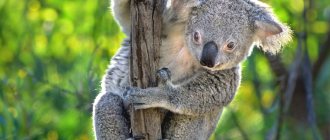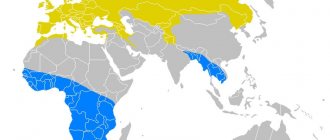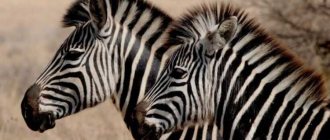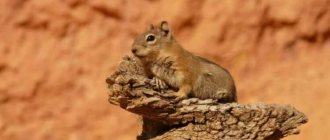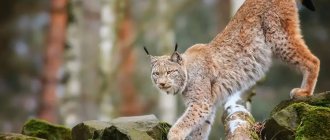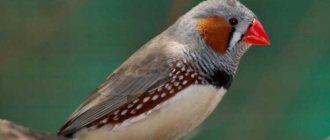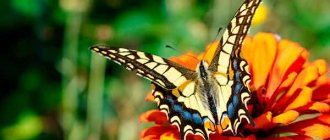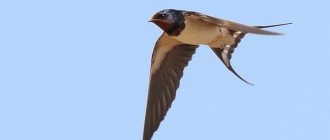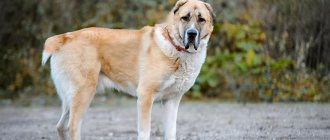- Where does the walrus live?
The very name of this animal has become a household word; walruses are sometimes called people who are not afraid of the cold, who are able to swim in an ice hole in winter, and so on. As for real walruses, these amazing animals are interesting not only because they are not afraid of the cold, living in cold Arctic regions, but also because walruses are the largest pinnipeds living in the northern hemisphere of our planet. Only the southern sea walrus is larger than walruses
an elephant related to walruses - seals, but it lives in Antarctica. And today’s heroes of our article, walruses, are, without exaggeration, the true giants of the Arctic.
Description, structure, characteristics
According to the zoological classification, all walruses belong to the family of walruses, the order of pinnipeds, that is, those with flippers instead of legs.
The size of a walrus, if it is a male, is on average 3-4.5 meters in length, female walruses are slightly smaller - they are 2.6-3.6 meters in length. The weight of a male walrus is 1.5-1.8 tons, females are slightly lighter, they weigh “only” 700-800 kg.
Externally, walruses are also somewhat similar to their relatives - eared seals. The body of the walrus, although very massive, is nevertheless distinguished by unexpected plasticity and mobility. The hind legs of a walrus are capable of bending at the heel joint, can bend under the body and take part in the movement of these animals.
But the main difference between walruses, both from other pinnipeds and other animals in general, their “signature calling card” is, of course, a pair of long fangs or tusks protruding from the upper jaw towards the ground.
Walrus tusks.
In females, the length of the fangs-tusks is on average 30-40 cm, while in males they can reach up to 80 cm. Why does a walrus need tusks? In fact, their tusks serve them for various practical purposes, primarily for self-defense from potential predators and to sort things out among themselves - male walruses sometimes quarrel with each other over females, and then their tusks are used. Walruses can also climb onto ice floes with the help of their tusks.
In addition to the fangs-tusks, walruses have sensitive hair on their face - vibrissae; the thickness of the vibrissae of an adult walrus is approximately the same as that of a wire.
The vision of walruses is poorly developed, but this deficiency is more than compensated by an excellent sense of smell, so walruses can easily smell, among other things, the smell of a person, retreating before he approaches.
The skin of the walrus is thick and rough, with insignificant rudiments of fur; in fact, the whiskers are the only hair on the body of walruses. The color of walruses is brown, but in older individuals sometimes pinkish spots on the skin are noticeable - these are traces of numerous scars and scratches acquired during the turbulent life of a walrus.
Real seal: features
In addition to the already mentioned characteristics of the appearance of a real seal, it must be said about the short neck and the same tail, the first being inactive. Vibrissae are usually up to ten pieces, they are quite hard. It is the whiskers that help seals navigate in the water: they do not rely on vision, but with the help of their whiskers they catch obstacles and successfully overcome them. The front flippers of these animals are even shorter than the hind ones and are located closer to the head. The size and weight of a real seal ranges from one and a half to six and a half meters and from ninety to three and a half thousand kilograms.
Some species of seals do not have hair, but it is usually rough, not fluffy, and comes in a variety of colors. Seals are characterized by seasonal molting. Babies are born with thick, often white and very soft fur, which is replaced after three weeks. Pregnancy in females lasts from two hundred seventy to three hundred and fifty days, and reproduction (as well as molting) occurs on ice. The peculiarity of real seals is that mothers stop feeding their young with milk quite early, and for several weeks the babies feed only on accumulated fat reserves (since they themselves are not yet able to provide themselves with food). In general, real seals eat fish, crustaceans, and mollusks. Some species even hunt penguins.
Nutrition
Walruses' favorite delicacies include sea worms, mollusks and crustaceans. With its powerful tusks, the walrus pierces the muddy bottom and picks up many shells from there, their shells are erased by flippers, and the mollusks themselves are eaten by walruses. The same thing happens with worms and crustaceans, which walruses literally sweep from the seabed to then eat. To be satiated, an adult walrus needs to eat at least 50 kg of food per day.
Walruses eat fish, but less readily than mollusks or worms; walruses may resort to hunting fish as a last resort, when there is no other food for them.
Enemies in nature
In turn, the walrus itself can become prey for killer whales at sea, white
on bearish land, and their third enemy (in any element) is, of course, man. The indigenous peoples of the North: the Chukchi and Eskimos, from ancient times hunted walruses (as well as seals), but they never killed more of them than they needed for food. The white man changed everything - the barbaric extermination of walruses by hunters and poachers in the last and century before last, carried out for the sake of their tusks, led to the fact that in our time the walrus population has greatly decreased and now these giants of the Arctic are listed in the Red Book, as they are brink of extinction.
Lifestyle
Walruses are herd animals and usually gather in small herds of 20-30 individuals, but at times they can create large rookeries of up to 3000 individuals. In a herd of walruses, the strongest male usually dominates; the remaining males periodically sort things out with him and with each other, but the main subject of dispute among male walruses is, of course, the females. But disputes and even fights for females between males occur exclusively during the mating season; the rest of the time, all walruses are very peaceful animals.
It is interesting that sentinels are located along the edges of walrus rookeries; having noticed the danger, they notify their fellows with a loud roar, after which the entire herd rushes into the water. Like seals, all walruses are excellent swimmers, capable of spending whole days in the water.
Rookeries
Walrus rookeries are a very interesting sight. There are a huge number of bodies lying on the stones, pressed tightly against each other. Some individuals crawl into the water, while others return to the rookery. In such a huge mass, both individual skirmishes and friendships are formed.
The peace of the rookery is guarded by shift sentries. In case of danger, the sentries roar, and massive carcasses instantly rush into the water. Children can die in such crushes. But more often the mother manages to save her offspring by covering them with her strong body. Walruses establish rookeries not only on land, but also on ice floes. Pack ice is not suitable for these purposes; only females give birth to offspring on it.
Types, photos and names
Zoologists distinguish only three subspecies of walruses, and below we will describe them in more detail.
Pacific walrus
The Pacific walrus is the largest walrus in the world, the male is 3.5-4.5 m long and weighs up to two tons. Females are slightly smaller. It lives in the northern part of the Far East - along the shores of the Bering Strait, in the Chukchi and Bering Seas and off the Kamchatka islands.
Atlantic walrus
This species is slightly smaller than its Pacific counterpart, its average length is 2.5-3 meters, females are several times smaller. It lives in the Kara Sea, the Barents Sea, on Franz Josef Land in the Arctic Ocean.
Laptev walrus
This species of walrus is the smallest and is currently endangered. It lives in the Central and Western parts of the Laptev Sea, in the eastern part of the Kara Sea and in the West of the East Siberian Sea. In terms of size, bast walruses occupy an intermediate state between the Pacific and Atlantic walruses.
Where do they live?
Walrus colonies are found in Arctic and subarctic waters. Habitat: coastal zones of the Arctic Ocean.
Where live
The natural habitat of the walrus is ice-covered areas near the coasts of Europe, Asia, North America, and Arctic islands with a depth to the bottom of 100-150 m. Pinnipeds do not settle near vast unfrozen water spaces and do not establish rookeries on pack ice.
Walruses are characterized by seasonal migrations. In the fall they move to the ice areas of the Bering Sea, and in the spring they return to their usual habitats in the Chukchi Sea. Males and females of the Pacific subspecies can cover up to 3,000 km during migration, moving by swimming and on drifting ice floes, while females with cubs swim further than males.
There is no detailed and reliable information about the migrations of Atlantic walruses due to a significant reduction in the size of this population. Presumably, they do not make such long journeys as their relatives.
Reproduction
Walruses reach sexual maturity at the age of five, and their mating season occurs in April-May; it is during this period that previously peaceful males become very aggressive and every now and then fight with each other (with the help of fangs-tusks, of course) for females. They, as expected, choose the strongest males as their sexual partners.
The pregnancy of a walrus lasts 340-370 days and only one calf is born at a time. In very rare cases, twins may be born. Little walruses are not so small - their body length is about 1 m and their weight is 30 kg. From the first days of life they learn to swim. For the first year of life, small walruses are breastfed, and only after a year they become able to eat food from adult walruses.
All walruses have a developed maternal instinct, they selflessly protect their cubs in case of danger, and in general are caring mothers. Until the age of three, while the young walrus has not yet grown its tusks, it stays next to its mother, and only after reaching the age of three, with already grown tusks, does it begin adult life.
How does a walrus behave?
Animals of this species prefer to live in a herd. Mutual assistance is well developed in their teams; they try to protect each other in case of danger. All the adults look after the little walruses and provide support. The herd is guarded by sentries who, with roars or some other signals, warn their relatives of danger.
The animals feed mainly on mollusks, but sometimes they eat fish and carrion. The famous tusks help in the extraction of shellfish. In addition to obtaining food, tusks are used for protection, movement on ice, and fights with other males.
They have an excellent sense of smell, they can sense a person from a great distance. Hearing is also well developed. The female is able to hear the roar of her cub, being two kilometers away from him. The equanimity of walruses is their distinctive feature .
They look around without turning their heads. These sea animals are excellent swimmers, and the person in the boat will have a hard time resisting them. The animal itself will not attack him , but as a defense it can sink the boat. It is capable of diving to depths of up to 180 meters.
The main dangers for him in the wild are polar bears and killer whales.
Interesting Facts
Video
And in conclusion, we bring to your attention an interesting documentary film about walruses filmed by the team of the famous Captain Cousteau - “The Smile of the Walrus”.
Author: Pavel Chaika, editor-in-chief of Poznavaika magazine
When writing the article, I tried to make it as interesting, useful and high-quality as possible. I would be grateful for any feedback and constructive criticism in the form of comments on the article. You can also write your wish/question/suggestion to my email [email protected] or Facebook, with respect, the author.
Author page
